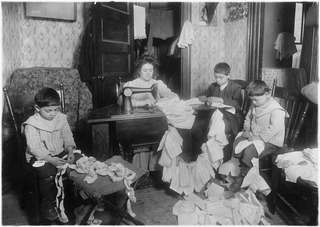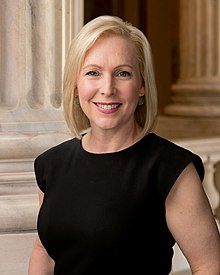
Textile is an umbrella term that includes various fiber-based materials, including fibers, yarns, filaments, threads, different fabric types, etc. At first, the word "textiles" only referred to woven fabrics. However, weaving is not the only manufacturing method, and many other methods were later developed to form textile structures based on their intended use. Knitting and non-woven are other popular types of fabric manufacturing. In the contemporary world, textiles satisfy the material needs for versatile applications, from simple daily clothing to bulletproof jackets, spacesuits, and doctor's gowns.

A sweatshop or sweat factory is a crowded workplace with very poor, socially unacceptable or illegal working conditions. Some illegal working conditions include poor ventilation, little to no breaks, inadequate work space, insufficient lighting, or uncomfortably/dangerously high or low temperatures. The work may be difficult, tiresome, dangerous, climatically challenging or underpaid. Workers in sweatshops may work long hours with unfair wages, regardless of laws mandating overtime pay or a minimum wage; child labor laws may also be violated. Women make up 85 to 90% of sweatshop workers and may be forced by employers to take birth control and routine pregnancy tests to avoid supporting maternity leave or providing health benefits. The Fair Labor Association's "2006 Annual Public Report" inspected factories for FLA compliance in 18 countries including Bangladesh, El Salvador, Colombia, Guatemala, Malaysia, Thailand, Tunisia, Turkey, China, India, Vietnam, Honduras, Indonesia, Brazil, Mexico, and the US. The U.S. Department of Labor's "2015 Findings on the Worst Forms of Child Labor" found that "18 countries did not meet the International Labour Organization's recommendation for an adequate number of inspectors."
Offshoring is the relocation of a business process from one country to another—typically an operational process, such as manufacturing, or supporting processes, such as accounting. Usually this refers to a company business, although state governments may also employ offshoring. More recently, technical and administrative services have been offshored.

The Garment District, also known as the Garment Center, the Fashion District, or the Fashion Center, is a neighborhood located in the borough of Manhattan in New York City. Historically known for its role in the production and manufacturing of clothing, the neighborhood derives its name from its dense concentration of fashion-related uses. The neighborhood, less than 1 square mile, is generally considered to lie between Fifth Avenue and Ninth Avenue, from 34th to 42nd Streets.

A Made in USA mark is a country of origin label affixed to homegrown, American-made products that indicates the product is "all or virtually all" domestically produced, manufactured and assembled in the United States of America. The label is regulated by the Federal Trade Commission (FTC).
A predetermined motion time system (PMTS) is frequently used to perform Labor Minute Costing in order to set piece-rates, wage-rates and/or incentives in labor (labour) oriented industries by quantifying the amount of time required to perform specific tasks under defined conditions. Today the PMTS is mainly used in work measurement for shorter cycles in labour oriented industries such as apparel and footwear. This topic comes under wider industrial and production engineering.

Piece work is any type of employment in which a worker is paid a fixed piece rate for each unit produced or action performed, regardless of time.

The Fair Labor Association (FLA) is a non-profit collaborative effort of universities, civil society organizations, and businesses.
The Design Piracy Prohibition Act, H.R. 2033, S. 1957, and H.R. 2196, were bills of the same name introduced in the United States Congress that would have amended Title 17 of the United States Code to provide sui generis protection to fashion designs for a period of three years. The Acts would have extended protection to "the appearance as a whole of an article of apparel, including its ornamentation," with "apparel" defined to include "men's, women's, or children's clothing, including undergarments, outerwear, gloves, footwear, and headgear;" "handbags, purses, and tote bags;" belts, and eyeglass frames. In order to receive the three-year term of protection, the designer would be required to register with the U.S. Copyright Office within three months of going public with the design.
In the clothing industry, fast fashion is the business model of replicating recent catwalk trends and high-fashion designs, mass-producing them at a low cost, and bringing them to retail stores quickly, while demand is at its highest. The term fast fashion is also used generically to describe the products of the fast fashion business model.

Sustainable fashion is a term describing products, processes, activities, and people that aim to achieve a carbon-neutral fashion industry built on equality, social justice, animal welfare, and ecological integrity. Sustainable fashion concerns more than fashion textiles or products, rather addressing the entire process in which clothing is produced, consumed and disposed of. The movement looks to combat the large carbon footprint that the fast fashion industry has created by reducing the environmental impact such as air pollution, water pollution and climate change. Sustainable fashion is a much more environmentally conscious means of clothing production compared to the fast fashion industry.

The textile and clothing industries provide a single source of growth in Bangladesh's rapidly developing economy. Exports of textiles and garments are the principal source of foreign exchange earnings. By 2002 exports of textiles, clothing, and ready-made garments (RMG) accounted for 77% of Bangladesh's total merchandise exports.
The New York State Department of Labor is the department of the New York state government that enforces labor law and administers unemployment benefits.
Advanced Fashion Design and Technology is a fashion-related manufacturing process that integrates new technologies.

The California Labor Code, more formally known as "the Labor Code", is a collection of civil law statutes for the State of California. The code is made up of statutes which govern the general obligations and rights of persons within the jurisdiction of the State of California. The stated goal of the Department of Industrial Relations is to promote and develop the welfare of the wage earners of California, to improve their working conditions and to advance their opportunities for profitable employment."
Zero-waste fashion refers to items of clothing that generate little or no textile waste in their production. It can be considered to be a part of the broader Sustainable fashion movement. Zero-waste fashion can be divided into two general approaches. Pre-consumer zero-waste fashion eliminates waste during manufacture. Post-consumer zero-waste fashion generates clothing from post-consumer garments such as second-hand clothing, eliminating waste at what would normally be the end of the product use life of a garment. Zero-waste fashion is not a new concept - early examples of zero-waste or near zero-waste garments include Kimono, Sari, Chiton and many other traditional folk costumes.
Clothing industry or garment industry summarizes the types of trade and industry along the production and value chain of clothing and garments, starting with the textile industry, embellishment using embroidery, via the fashion industry to apparel retailers up to trade with second-hand clothes and textile recycling. The producing sectors build upon a wealth of clothing technology some of which, like the loom, the cotton gin, and the sewing machine heralded industrialization not only of the previous textile manufacturing practices. Clothing industries are also known as allied industries, fashion industries, garment industries, or soft good industries.

Arvind Limited is a textile manufacturer and the flagship company of the Lalbhai Group. Its headquarters are in Naroda, Ahmedabad, Gujarat, India, and it has units at Santej. The company manufactures cotton shirting, denim, knits and bottomweight (khaki) fabrics. It has also recently ventured into technical textiles with its Advanced Materials Division in 2011. It is India's largest denim manufacturer.
The textile industry in China is the largest in the world in both overall production and exports. China exported $274 billion in textiles in 2013, a volume that was nearly seven times that of Bangladesh, the second largest exporter with $40 billion in exports. This accounted for 43.1% of global clothing exports. According to Women's Wear Daily, they account for more than 50 percent of the world's total overall production, exports, and retail.China is one of the most appealing destinations for apparel manufacture. China produced around 23.5 billion units of garments in 2021.As of 2022, their textile and garment exports total up to around $316 billion and their retail up to $672 billion. China has been ranked as the world's largest manufacturer since 2010.

The CHIPS and Science Act is a U.S. federal statute enacted by the 117th United States Congress and signed into law by President Joe Biden on August 9, 2022. The act provides roughly $280 billion in new funding to boost domestic research and manufacturing of semiconductors in the United States. The act includes $39 billion in subsidies for chip manufacturing on US soil along with 25% investment tax credits for costs of manufacturing equipment, and $13 billion for semiconductor research and workforce training, with the primary aim of countering China.












